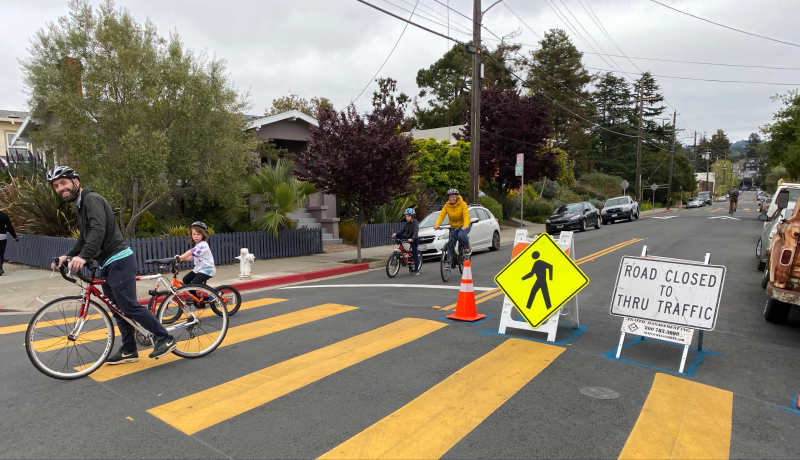Note: GJEL Accident Attorneys regularly sponsors coverage on Streetsblog San Francisco and Streetsblog California. Unless noted in the story, GJEL Accident Attorneys is not consulted for the content or editorial direction of the sponsored content.
Top bike researchers Ralph Buehler and John Pucher scoured worldwide research reports to study the question of how bicycling policies changed during the pandemic, and how that affected bicycling rates. They looked at peer-reviewed studies from six continents, 53 countries, and 261 cities. Europe and the USA accounted for the most cases studied, but Asia, Canada, Australia, Latin America, and Africa were all represented in the samples.
They found that bicycling rates, in general, increased during pandemic travel restrictions, with some variation based on place and other factors. They have discussed some of their findings at Streetsblog USA, and have now published a paper taking a wider look at lessons learned from what cities did - and sometimes undid - to keep people safe.
In mid-2020, widespread media reports heralded a "boom" in bicycling and shortages of bicycles and bicycle parts as a result. "The largest increases in cycling in 2020 were for recreation, exercise, and stress relief on weekends and weekday afternoons," they found. By comparison, cycling to work, university, schools, and shopping generally declined. Then again, at that time so did all trips for those purposes.
"Assessing the effects of COVID-19 on cycling is important because cycling is a sustainable means of transport for traveling short to medium distances, especially in urban areas," write the authors.
Moreover, [bicycling] has served as an alternative to public transport for some trips and for some people during the pandemic. In addition, increased cycling may have helped offset the reduction in physical activity due to the temporary closure of gyms, fitness centers, swimming pools, and athletic events during peaks of the pandemic.
Most of the studies they examined "reported expansions or improvements in bikeway networks, often specifically related to COVID or accelerated due to COVID, and with a particular emphasis on low-stress facilities such as protected bike lanes, slow streets, car-free streets, and traffic-calmed neighborhood streets."
One study, using data from March through August 2020, identified over a thousand specific street space reallocation measures including shifts of motor vehicle travel lanes to cycling or walking, full or partial street closures vehicles, and bike-share expansions or bike rental discounts. During 2020, approximately 200 U.S. cities reallocated street space to allow for safe outdoor activity, including cycling.
In the fourteen large European and North American cities they examined, Buehler and Pucher found all of them expanded and improved their cycling infrastructure, mainly by building protected bike lanes. Some of those started as pop-up bike lanes, but were made permanent because they were successful in attracting more cycling. Some of them had been planned already, and existed on paper in bike plans, but their installation was accelerated during COVID. Most of these cities widened bike lanes and added buffering and design improvements. They also increased the amount of funding they put towards expanding and improving their bicycling networks.
There was also a 21 percent increase in the total length of off-road, shared-use paths for cyclists and pedestrians during the three years between December 2019 and December 2022.
Many of these pro-bicycling policies and designs would have been unthinkable before the pandemic, as they were generally opposed by drivers, but the emergency situation and the drop in travel made experimenting with them possible. The researchers found that COVID-era experience with this wide range of new and expanded measures "revealed the effectiveness of low-stress, safe facilities such as protected bike lanes, off-road paths, slow streets, school streets, and traffic-calmed neighborhoods to encourage a wider range of the population to ride bikes."
Several studies that examined the relationship between new cycling infrastructure and cycling levels found that cycling rates increased in mid to late 2020 between 11 and 48 percent compared to cycling on the same streets before COVID. Other studies found similar and larger increases in the amount of cycling. Because total travel declined during that time period, bike mode share rose even higher as a percentage of total travel.
One study in Vancouver found that the largest increases in bike riding in that city happened on "comfortable riding spaces” such as protected on-street bike lanes and bikeways in and near parks. Another in Glasgow found that the highest increases were on protected bikeways.
But not all these changes were permanent. One report found that bike lanes were the most likely street change to be made permanent - some of them would have been planned before the pandemic, and their implementation speeded up while so many people stayed at home. Some open streets measures were also made permanent, but overall, one study found that only six of thirty large American cities had made COVID measures permanent. Overall, 75 percent of the 483 measures they tracked were only short-term and not permanent.
However, many of the studies concluded by recommending further expansions of low-stress facilities, rather than retractions and take-backs, since they were effective in getting people of all ages and abilities to use bikes.
None of this may strike anyone as much of a surprise; everyone witnessed tremendous changes in travel during the pandemic shut downs. But Buehler and Pucher's research supplies further strong evidence that safe, "comfortable" places to ride are the most effective ways of getting people on bikes.
And since that is an official policy direction in the state of California, for climate, health, and safety reasons, the clear conclusion is that these kinds of facilities need to be increased in our cities, and quickly.
The paper is available to the public for a limited time at this link. Detailed information about methods and sources can be found there.






